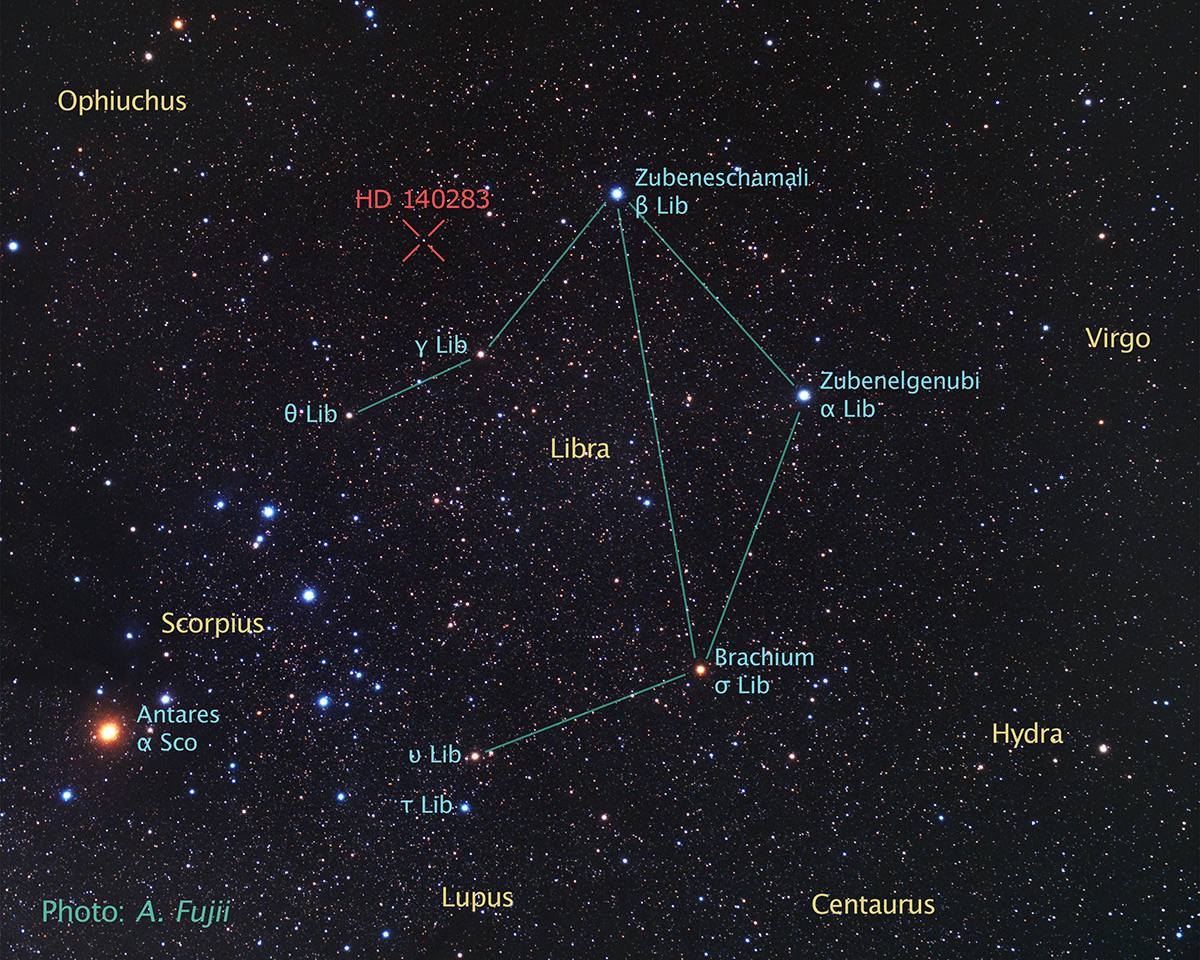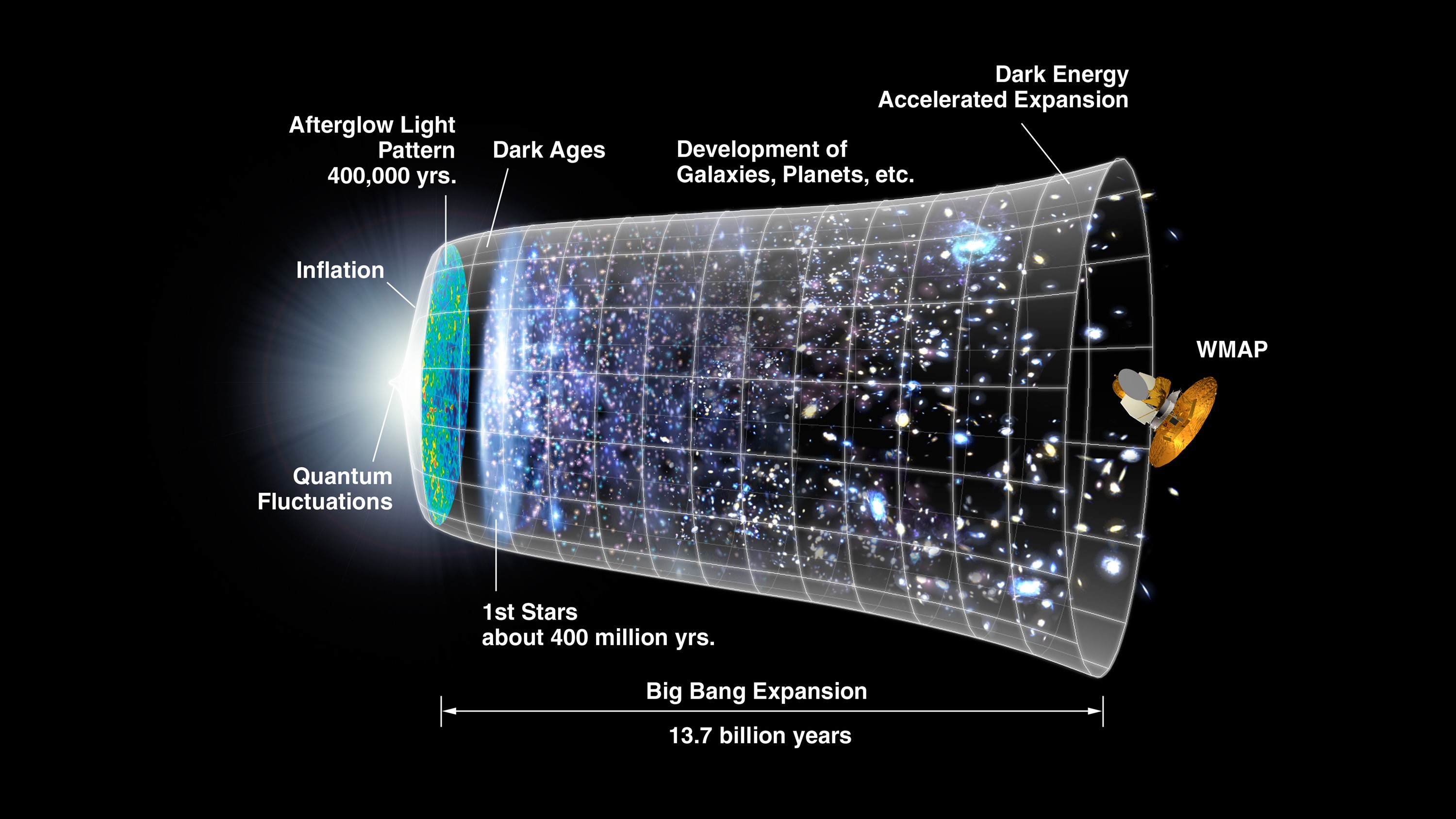Methuselah: The oldest star in the universe
How can a star be older than the universe?

In 2000, scientists looked to date what they thought was the oldest star in the universe. They made observations via the European Space Agency's (ESA) Hipparcos satellite and estimated that HD140283 — or Methuselah as it's commonly known — was a staggering 16 billion years old.
Such a figure was rather baffling. After all, the age of the universe — determined from observations of the cosmic microwave background — is 13.8 billion years old, so how can a star be older than the universe?
"It was a serious discrepancy," says astronomer Howard Bond of Pennsylvania State University. So with that in mind, Bond and his colleagues set out to discover the truth and test the accuracy of the figure. Their conclusions were just as mind-blowing.
Related: The Methuselah Star: Oldest known star revealed (gallery)
Astronomers began observing Methuselah — named in reference to a biblical patriarch who is said to have died aged 969, making him the longest-lived of all the figures in the Bible — more than 100 years ago. The curious star is located some 190 light-years away from Earth in the constellation Libra and it rapidly journeys across the sky at 800,000 mph (1.3 million kilometers per hour).
– Methuselah covers the width of the moon in the night sky every 1,500 years.
– You can't see Methuselah with the naked eye. It can only be seen using a telescope
– It contains just 1/250th of the iron content of our sun
It was clear that the star was old. The metal-poor subgiant is predominantly made of hydrogen and helium and contains very little iron. Such composition meant the star must have come into being when helium and hydrogen dominated the universe and before iron became commonplace (the heavier elements only appeared when massive stars created them in their cores)
But could Methuselah really be more than two billion years older than its environment? Surely that is just not possible. Either the star was older than the universe or the universe was not as "young" as scientists thought it to be. Or maybe the dating was simply all wrong. What was it to be?
Breaking space news, the latest updates on rocket launches, skywatching events and more!
Investigating the age of Methuselah
A mystery of this magnitude could not be ignored so Bond and his colleagues attempted to unearth the truth by pouring over 11 sets of observations that had been recorded between 2003 and 2011.
These observations had been made by the Fine Guidance Sensors of the Hubble Space Telescope, which noted the positions, distances and energy output of stars. In acquiring parallax, spectroscopy and photometry measurements, the scientists could determine a better sense of age.
"One of the uncertainties with the age of HD 140283 was the precise distance of the star," Bond said. "It was important to get this right because we can better determine its luminosity and, from that, its age — the brighter the intrinsic luminosity, the younger the star.
"We were looking for the parallax effect, which meant we were viewing the star six months apart to look for the shift in its position due to the orbital motion of the Earth, which tells us the distance."
Bond adds that there were also uncertainties in the theoretical modeling of the stars, such as the exact rates of nuclear reactions in the core and the importance of elements diffusing downwards in the outer layers. So they worked on the idea that leftover helium diffuses deeper into the core, leaving less hydrogen to burn via nuclear fusion. With fuel used faster, the age is lowered.
"Another factor that was important was, of all things, the amount of oxygen in the star," Bond said. HD 140283 had a higher than predicted oxygen-to-iron ratio and, since oxygen was not abundant in the universe for a few million years, it pointed again to a lower age for the star.
As a result of all of this work, Bond and his collaborators estimated HD 140283's age to be 14.46 billion years. It was a significant reduction on the 16 billion previously claimed but it was still more than the age of the universe itself.
In that sense, it didn't clear up the mystery and, on the face of it, simply ensured Methuselah remained a curiosity. But the scientists posed a residual uncertainty of 800 million years, which Bond said made the star's age compatible with the age of the universe. It was a major breakthrough.
Related: Test your knowledge in this star quiz
"Like all measured estimates, it is subject to both random and systematic error," said physicist Robert Matthews of Aston University in Birmingham, UK, who was not involved in the study. "The overlap in the error bars gives some indication of the probability of a clash with cosmological age determinations"
"In other words, the best-supported age of the star conflicts with that for the derived age of the universe [as determined by the cosmic microwave background], and the conflict can only be resolved by pushing the error bars to their extreme limits."
Further refinements saw the age of HD 140283 fall a bit more. A 2014 follow-up study, for instance, updated the star's age to 14.27 billion years. "Again, if one includes all sources of uncertainty — both in the observational measurements and the theoretical modeling — the error is about 700 or 800 million years, so there is no conflict because 13.8 billion years lies within the star's error bar," Bond said.
What's more, in May 2021, another group of astronomers revised the best estimates for the age and mass of Methuselah and, having modeled how stars change over time, they found its age to be 12 billion years. It still makes HD 140283 extremely old (the sun, by comparison, is only a kid at 4.6 billion years old) but it puts the age of the star well and truly within the age of the universe. Or does it?
Investigating the age of the universe
On the one hand, Bond says the efforts to date Methuselah is "an amazing scientific achievement which provides very strong evidence for the Big Bang picture of the universe". By showing similarities between the age of the universe and that of this old nearby star, he says the problem with the age of the oldest stars is far less severe than it was in the 1990s when the stellar ages were approaching 18 billion years or, in one case, 20 billion years. "With the uncertainties of the determinations, the ages are now agreeing," Bond said.
Yet, on the other hand, Matthews believes the problem has not yet been resolved. Astronomers at an international conference of top cosmologists at the Kavli Institute for Theoretical Physics in Santa Barbara, California, in July 2019 were puzzled over studies that suggested different ages for the universe. They were looking at measurements of galaxies that are relatively nearby which suggest the universe is younger by hundreds of millions of years compared to the age determined by the cosmic microwave background.
Related: 7 surprising things about the universe
Far from being 13.8 billion years old, as estimated by the European Planck space telescope's detailed measurements of cosmic radiation in 2013, the universe may be as young as 11.4 billion years. If that is, indeed, the case, then Methuselah is one again older than the universe. The plot, indeed, thickens, but how accurate are these re-estimates proving to be?
One of those behind the studies to date the universe is Nobel laureate Adam Riess of the Space Telescope Science Institute in Baltimore, Maryland.
The conclusions are based on the idea of an expanding universe, as shown in 1929 by Edwin Hubble. This is fundamental to the Big Bang — the understanding that there was once a state of hot denseness that exploded out, stretching space. It indicates a starting point that should be measurable, but fresh findings are suggesting that the expansion rate is around 10% higher than the one suggested by Planck.
Indeed, the Planck team determined that the expansion rate was 67.4 km per second per megaparsec, but more recent measurements taken of the expansion rate of the universe point to values of 73 or 74.
That means there is a difference between the measurement of how fast the universe is expanding today and the predictions of how fast it should be expanding based on the physics of the early universe, Riess said. It's leading to a reassessment of accepted theories while also showing there is still much to learn about dark matter and dark energy, which are thought to be behind this conundrum.
Related: 5 weird facts about seeing the universe's birth
A higher value for the Hubble Constant indicates a shorter age for the universe. A constant of 67.74 km per second per megaparsec would lead to an age of 13.8 billion years, whereas one of 73, or even as high as 77 as some studies have shown, would indicate a universe age no greater than 12.7 billion years.
It's a mismatch that suggests, as stated, that HD 140283 could still be older than the universe. It has also since been superseded by a 2019 study published in the journal Science that proposed a Hubble Constant of 82.4 — suggesting that the universe's age is only 11.4 billion years. Astronomers are hoping the James Webb Space Telescope could shed light on this particular mystery.
Matthews believes the answers lie in greater cosmological refinement. "I suspect that the observational cosmologists have missed something that creates this paradox, rather than the stellar astrophysicists," he said, pointing to the measurements of the stars being perhaps more accurate.
"That's not because the cosmologists are in any way sloppier, but because the age determination of the universe is subject to more and arguably trickier observational and theoretical uncertainties than that of stars."
Why does the universe appear younger than Methuselah?
But what could be making the universe potentially appear younger than this particular star?
"There are two options, and the history of science suggests that in such cases the reality is a mix of both," Matthews said. "In this case that would be sources of observational error that haven't been fully understood, plus some gaps in the theory of the dynamics of the universe, such as the strength of dark energy, which has been the prime driver of the cosmic expansion for many billions of years now."
Related: Dark matter and dark energy mystery explained (infographic)
He suggests the possibility that the current "age paradox" reflects time variation in dark energy, and thus a change in the rate of acceleration — a possibility theorists have found might be compatible with ideas about the fundamental nature of gravity, such as the so-called causal set theory. New research into gravitational waves could help to resolve the paradox, Matthews said.
To do this, scientists would look at the ripples in the fabric of space and time created by pairs of dead stars, rather than relying on the cosmic microwave background or the monitoring of nearby objects such as Cepheid variables and supernovae to measure the Hubble Constant — the former resulting in the speed of 67 km per second per megaparsec and the latter in 73.
Trouble is, measuring gravitational waves is no easy task, given they were only directly detected for the first time in 2015. But according to Stephen Feeney, an astrophysicist at the Flatiron Institute in New York, a breakthrough could be made over the next decade. The idea is to collect data from collisions between pairs of neutron stars using the visible light these events emit to figure out the speed they are moving relative to Earth. It also entails analyzing the resulting gravitational waves for an idea of distance — both of which can combine to give a measurement of the Hubble Constant that should be the most accurate yet.
The mystery of the age of HD 140283 is leading to something bigger and more scientifically complex, altering the understanding of how the universe works.
"The most likely explanations for the paradox are some overlooked observational effect and/or something big missing from our understanding of the dynamics of the cosmic expansion," Matthews said. Precisely what that "something" is, is sure to keep astronomers challenged for some time.
Additional resources
Learn more about the Fine Guidance Sensors of the Hubble Space Telescope. Watch this cool history of the Hubble Space Telescope. Discover how WMAP has been making measurements of cosmology and determining the age of the universe.
Bibliography
- Tang, Jianling, and Meridith Joyce. "Revised Best Estimates for the Age and Mass of the Methuselah Star HD 140283 Using MESA and Interferometry and Implications for 1D Convection." Research Notes of the AAS 5.5 (2021): 117.
- Lincoln, Don. "Have Astronomers Found a Star Older Than the Universe?." The Physics Teacher 59.3 (2021): 154-158.
- Bond, Howard E., et al. "HD 140283: A star in the solar neighborhood that formed shortly after the Big Bang." The Astrophysical Journal Letters 765.1 (2013): L12.
- Catelan, M. "The ages of (the oldest) stars." Proceedings of the International Astronomical Union 13.S334 (2017): 11-20.

David Crookes is a UK-based science and technology journalist who has been writing professionally for more than two decades. Having studied at the University of Durham in England, he has written for dozens of newspapers, magazines and websites including The Independent, The i Paper, London Evening Standard, BBC Earth, How It Works and LiveScience. He has been a regular contributor to Space.com's sister publication, All About Space magazine since 2014.



